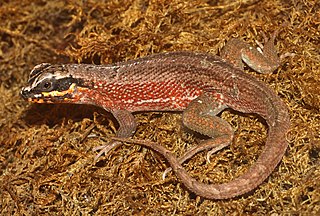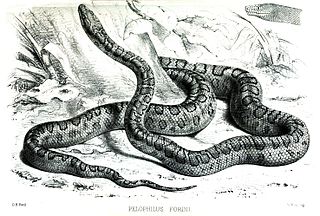
Leiocephalidae, also known as the curlytail lizards or curly-tailed lizards, is a family of iguanian lizards restricted to the West Indies. One of the defining features of these lizards is that their tail often curls over. They were previously regarded as members of the subfamily Leiocephalinae within the family Tropiduridae. There are presently 29 known species, all in the genus Leiocephalus.

Caribicus warreni, commonly known as the Haitian giant galliwasp or the Hispaniolan giant galliwasp, is a species of lizard in the family Diploglossidae. The species is endemic to the island of Hispaniola.
The Navassa curly-tailed lizard or Navassa curlytail lizard is an extinct lizard species from the family of curly-tailed lizard (Leiocephalidae). It is known only from the holotype, a female specimen from which it was described in 1868. A possible second specimen which was collected by Rollo Beck in 1917 was instead identified as a Tiburon curly-tailed lizard by herpetologist Richard Thomas in 1966.
The Martinique curlytail lizard is an extinct species of lizard in the family of curly-tailed lizard (Leiocephalidae).

The Hispaniolan masked curly-tailed lizard is a lizard species from the family of curly-tailed lizard (Leiocephalidae). It is also known as the Hispaniolan masked curlytail, Haitian curlytail lizard and the green-legged curly-tail. endemic to the Caribbean island of Hispaniola.

Leiocephalus carinatus, commonly known as the northern curly-tailed lizard or saw-scaled curlytail, is a species of lizard in the family Leiocephalidae.
Leiocephalus loxogrammus, commonly known as the Rum Cay curlytail lizard and the San Salvador curlytail, is a lizard species in the family of curly-tailed lizard (Leiocephalidae). The species is endemic to The Bahamas and is only known to be found on San Salvador Island and Rum Cay.
Leiocephalus greenwayi, commonly known as the East Plana curlytail or Plana Cay curlytail lizard, is a species of lizard in the family of curly-tailed lizard (Leiocephalidae).
Leiocephalus inaguae, commonly known as the Inagua curlytail lizard, is a species of lizard in the family Leiocephalidae.

Anolis distichus, the bark anole, North Caribbean bark anole, or Hispaniolan gracile anole, is a species of anole lizard native to Hispaniola and the Bahamas, and introduced to Florida, where it was first recorded in 1946. It spends most its time on tree trunks. There are several subspecies and it is highly variable in color. Its body ranges from gray-brown to green, and the dewlap is cream-white, over yellow and orange to red. In Florida, most are gray-brown with a cream-white dewlap, but more greenish individuals with a yellow-edged red dewlap also occur. It is a fairly small anole, reaching up to 12.7 cm (5.0 in) in length.

Chilabothrus fordii, known commonly as Ford's boa or the Haitian ground boa, is a species of snake in the family Boidae.

Chilabothrus striatus, the Hispaniolan boa, is a species of snake in the family Boidae. The species is endemic to Hispaniola. The species is regularly found in the international pet trade.

Uromacer catesbyi, also known commonly as the blunt-headed Hispaniolan vinesnake and Catesby's pointed snake, is a species of snake in the family Colubridae. The species is endemic to the island of Hispaniola.

Aristelliger lar, also known as the Hispaniolan giant gecko and the spotted Caribbean gecko, is a species of lizard in the family Sphaerodactylidae. The species is endemic to the island of Hispaniola.

Cercosaura schreibersii, known commonly as Schreibers's many-fingered teiid or the long-tailed little lizard, is a species of lizard in the family Gymnophthalmidae. The species is endemic to South America.

Leiocephalus sixtoi, also known as the Hispaniolan dune curlytail, the dune curly-tailed lizard, or Sixto'scurly-tailed lizard is a species of lizard in the family Leiocephalidae. This species is endemic to the island of Hispaniola, and is only known in the sandy spaces of monumento natural Las Dunas de las Calderas, also known as Las Dunas de Baní.
Anolis christophei, also known commonly as the big-fanned trunk anole and the King Christophe anole, is a species of lizard in the family Dactyloidae. The species is endemic to the island of Hispaniola.
Leiocephalus semilineatus, commonly known as the Hispaniolan pale-bellied curlytail, Thomazeau curlytail lizard, or pale-bellied Hispaniolan curlytail, is a species of lizard in the family Leiocephalidae. It is native to Hispaniola.
Leiocephalus etheridgei, commonly known as the Morovis curlytail, is an extinct species of lizard in the family Leiocephalidae. The species was native to Puerto Rico.
Panolopus curtissi, also known commonly as Curtiss' galliwasp, Curtis's galliwasp, and the Hispaniolan khaki galliwasp, is a species of lizard in the family Diploglossidae endemic to the island of Hispaniola and surrounding islets.













